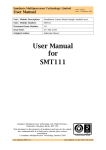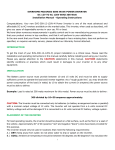Download Safe-man 2 Manual
Transcript
Safe-man Productivity System ™ Model: Safe-man 2.0 Sponge-Jet, Inc. 235 Heritage Ave., Suite 2, Portsmouth, NH 03801 USA +1-603-610-7950 / www.spongejet.com Safe-man User Manual - 5 August 2010 Table of Contents Section Page 1.0 Introduction 3 2.0 Safety Checklist 5 3.0 Requirements 6 4.0 Installation 7 5.0 Operation 14 6.0 Maintenance 16 7.0 Troubleshooting 18 Notes 19 IMPORTANT NOTE: While parts, systems, components, operational procedures may be the same between equipment models, the images provided in this manual may vary from model to model. 1.0 Introduction Basic Components 1: Control Panel 1 2: Nozzle Holder (not included) 2 3: Control Pad 4: Nozzle (not included) 5: LED Light Assembly 6: Protective Lens Cover 7: Mounting Screw 8: O-Ring 4 9: Green Tubing 10: In-line Deadman 11: Neoprene Sleeve 3 12: In-line Deadman Equalizing Valve 5 13: Gorilla Cable™ (extensions sold separately) 14: Hanging Bracket 15: Control Panel Power Mains Plug 5 12 6 9 10 11 13 7 14 15 8 Safe-man User Manual - 5 August 2010 Page 3 of 19 Basic Components (continued) Control Panel (front view) 16: Control Panel (front view) 16 17: DC Power Terminal 18: Mains AC Power Socket 19: Feed Unit Socket (Solenoid Valves) 20: Deadman Control Socket 20 19 18 17 21: Control Panel (rear view) Control Panel (back view) 22: Deadman Solenoid Valve IN-LINE DEADMAN VALVE: MODE ON/OFF ABRASIVE CONTROL VALVE: BLAST MODE ON/OFF 23: Signal Air – Deadman (Blasting) 24: Supply Air 25: Abrasive Solenoid Valve 26: Supply Air 22 23 27: Signal Air – Abrasive Control 25 21 24 Safe-man User Manual - 5 August 2010 26 27 Page 4 of 19 2.0 Safety Checklist Safe-man User Manual - 5 August 2010 o This Unit contains electrical and pressurized components which control a pressurized system. Only trained operators should adjust, maintain and repair it. o Be sure to observe all applicable safety requirements from the blast unit manufacturer as well as industrial, local, state/province and government regulations. o Inbound pressure should never exceed 8.6bar (125psi). o To prevent electrostatic buildup and possible electric discharge, the unit must be grounded at the black DC Power Terminal. o Operators and people in proximity to blasting should always wear eye and hearing protection with appropriate respiratory equipment and clothing, which may depend on the type of coating or contaminant being removed. o Improper configuration and installation may cause unintentional start-up and can result in personal injury. Contact Sponge-Jet Technical Services at [email protected]/+1-603-610-7950 for assistance. o This unit is not designed to operate in heavy rain, snow or temperature extremes. Page 5 of 19 3.0 Requirements 3.1 Equipment Requirements ______________________________________________________________ Safe-man™ Systems are designed to operate with Sponge-Jet Feed Unit™s and other conventional abrasive blast vessels. Unit functionality depends on functionality of the abrasive blasting vessel. This unit is designed to operate up to 91m (300 ft) from the abrasive blasting vessel. This unit provides three basic functions: LED Nozzle Light In-line Deadman; functions as on/off control of blast vessel OR Blast mode setting switches between blasting with air only (air wash) and blasting with air and abrasives (normal blasting). TO UTILIZE THIS FUNCTION, THE ABRASIVE BLAST VESSEL MUST HAVE THIS PNEUMATIC CONTROL FEATURE. NOTE: all Sponge-Jet Feed Unit™ models have this feature. 3.2 Power Requirements ______________________________________________________________ This unit can operate with either AC or DC power supply. AC operating range is 90-264 volts, 47-63Hz (80watts) DC operating range is 10-15 volts 10amp (120watts). Note: DC is typically connected to compressor battery with an adequate sized alternator. Safe-man User Manual - 5 August 2010 Page 6 of 19 4.0 Installation 4.1 Grounding ______________________________________________________________ To prevent electrostatic buildup and possible electric discharge, harm to the unit or to the operator, the unit must ALWAYS be properly grounded / bonded. 1 2 3 4 5 6 4.2 Connecting AC Power ______________________________________________________________ 1 Safe-man User Manual - 5 August 2010 2 3 Page 7 of 19 4.3 Connecting DC Power ______________________________________________________________ 2 1 3 4 DC Power Wire Gauge Requirements Maximum Distance Wire Gauge Up to 7.5m (25ft) 14 Up to 15m (50ft) 12 Up to 28m (75ft) 10 4.4 Connecting Control Panel (Cables) ______________________________________________________________ 1b 1a 2 Rear View 3 A A Safe-man User Manual - 5 August 2010 Page 8 of 19 4.5 Connecting Control Panel (In-line Deadman Valve) ______________________________________________________________ Connect yellow twinlines where pneumatic Deadman typically connect. If system architecture and fittings are not the same, see section 4.7 Connecting Control Panel (Customized Connection). Rear View 1 2 1 2 (Sponge-Jet Models ONLY) 4.6 Connecting Control Panel (Abrasive Control Valve) ______________________________________________________________ Figure 1 – Feed Unit Set-up Schematic Feed Unit Control Panel Old Green Pneumatic Tubing Disconnect from fittings at both ends and leave in place. New Green Pneumatic Tubing (cut each section to length) Safe-man Control Panel New Yellow Twinline (from Safe-man Control Panel) Green Gorilla Cable Old Yellow Twinline & Deadman Disconnect and store for troubleshooting Safe-man User Manual - 5 August 2010 Safe-man Control Pad Page 9 of 19 4.6 Connecting Control Panel (Abrasive Control Valve) ______________________________________________________________ (continued) For Sponge-Jet Models ONLY 1. Locate Green Tubing which connects to Feed Unit Auger Motor 2. Disconnect Green Tubing; do not discard 3. Follow Green Tubing to Feed Unit Control Panel, disconnect it; Feed Unit Auger Motor do not discard 4. Go to Step 5 How to Disconnect Pneumatic Tubing Control Panel 5 Feed Unit Control Panel Green Pneumatic Tube 6 1 Press tube down Replace old Green Tubing Cut new Green Tubing to with new Green Tube needed length 7 2 Hold return ring down 3 Pull tube out Insert new Green Tubing from Feed Unit Control Panel into Supply of Abrasive Control Solenoid Valve on Safe-man Control Panel 10 8 Insert leftover new Green Tubing into “Signal Air” fitting of Abrasive Control Solenoid Valve of Safeman Control Panel 9 Insert the other end of new Green Tubing into fitting that leads to Feed Unit Auger Motor 11 Cut excess Green Tubing if desired Safe-man User Manual - 5 August 2010 Page 10 of 19 4.7 Connecting Control Panel (Customized Connection) ______________________________________________________________ The Safe-man controls pneumatic solenoid valves which send signals to the blast vessel. Solenoid valves can be customized to accommodate the on/off or off/on requirements of other non-Sponge-Jet blast vessels. This unit is factory-configured to work with Sponge-Jet Feed Units and works with most other units. Use Figure 2 to match the air signal function to the desired function of your blast vessel. Figure 2 – Safe-man Solenoid Schematic (Safe-man Back View) Deadman Solenoid Control D2 (typically plugged) ~ Abrasive Shut-off Solenoid ~~ Air Relief (Bleed) = ~ Control D1 Control M2 (typically plugged) ~ Control M1 Supply Deadman Solenoid Control D1 Control D2 (Installed from Factory) (Plugged from Factory) Activated / ON – Blast Mode Air Signal No Air Signal Inactivated / OFF – Not Blasting No Air Signal Air Signal Shut Down (no power) No Air Signal Air Signal Control M1 Control M2 (Installed from Factory) (Plugged from Factory) Abrasive Air Signal No Air Signal No Abrasive No Air Signal Air Signal Shut Down (no Power) No Air Signal Air Signal In-line Deadman Function Abrasive Shut-Off Valve Control Pad Mode Safe-man User Manual - 5 August 2010 Page 11 of 19 4.8 Assembling Control Pad and In-line Deadman ______________________________________________________________ NOTE: Adjust Safe-man Neoprene Sleeve to lay flat. NEVER locate In-line Deadman on inside curve of blast hose CAUTION: Never use Safe-man when In-line Deadman has severe creases or folds. This condition can uncontrollably activate blasting. 1 2.5cm (1in) 2 3 4 5 6 7 8 Optional - for infrequent nozzle changes Safe-man User Manual - 5 August 2010 Page 12 of 19 4.8 Assembling Control Pad and In-line Deadman (continued) ______________________________________________________________ 10 11 12 Open and close Deadman Equalizing Valve 13 B B 14 C 15 C To Safe-man Control Pad To Safe-man Control Panel __________________________________________________________________________________________________ + One end of Gorilla Cable plugs into Safe-man Safe-man User Manual - 5 August 2010 + The other end of Gorilla Cable plugs into Gorilla Cable leading to Safe-man Control Pad. Note: additional Gorilla™ cable extensions can be added as needed. Page 13 of 19 5.0 Operation Before Operating the Safe-man: o Verify the Feed Unit™ (blast vessel) is properly setup and operating correctly – as directed by manufacturer. o Verify that unit is secured in an appropriate manner for operation. o Inspect all Blast Hoses and connections. Repair or replace worn or damaged components. Ensure all couplings are equipped with coupling gaskets, safety pins and hose restraints – and all are properly installed. o Insure blast vessel, its hoses and Safe-man black DC port are properly grounded. Figure 2 – Safe-man Control Panel Operation (AC) Mains Power: LIGHT: Indicates Mains (AC) Indicates LED Power is connected Nozzle Light is properly OR connected and operating DC Battery Power: NOZZLE: Indicates Battery Indicates Control Pad is Power (12 volt DC) properly connected is connected BLAST: AIR ONLY: STANDBY: Indicates Air and Abrasives are exiting the Nozzle Indicates Air only is exiting Nozzle Indicates neither Air nor Abrasives and Air are exiting the nozzle Safe-man User Manual - 5 August 2010 Page 14 of 19 Figure 2 – Safe-man Control Pad Operation Green Safety Switch = and Indicator Light Indicator lights… Indicator lights… In-line Deadman = = Air Only Mode Connection to a powered control box = = Air and Abrasives Mode Red ON/OFF Mode Switch = = Blast Mode Activated - Toggles Abrasive Cut-off Valve ON/OFF. - Also deactivates Deadman (Off). USING THE CONTROL PAD MODE As a Deadman… + Press and Hold to Blast Safe-man User Manual - 5 August 2010 Press and Release (Green Safety) Press Switch and Release; toggles between ON/OFF of abrasive shut-off valve Page 15 of 19 6.0 Maintenance Routine maintenance is required to provide long and reliable equipment life. This Unit must be shut down and disconnected prior to conducting maintenance. Prior to each use: ______________________________________________________________ Safe-man User Manual - 5 August 2010 • Inspect all hoses, cables, connections and buttons for excessive or abnormal wear and damage. • Inspect Protective Lens Cover for damage. Page 16 of 19 If______________________________________________________________ sensitivity of Deadman changes: • Safe-man User Manual - 5 August 2010 Reset In-line Deadman pressure by removing and reinserting the cap on In-line Deadman Equalizing Valve Page 17 of 19 7.0 Troubleshooting No nozzle output when depressing In-line Deadman and triggering (press and release) Green Safety Button Check Control Panel indicator “Nozzle” light is illuminated. If Control Panel indicator has power but “Nozzle” light is NOT illuminated… Check connections from Control Pad to In-line Deadman and Gorilla Cable extensions. If Control Panel Indicator “Nozzle” light is illuminated and Control Panel indicator lights work when switches are depressed, inspect/replace solenoid. Confirm In-line Deadman Equalizing Valve is tightly mounted, check for obstructions; check rubber seal. If necessary remove, clean/replace, insert and re-tighten. LED Nozzle Light shuts off or blinks slowly This is normal operation, IF Safe-man has been sitting without air flow from blasting. To remain cool (in absence of air flow) LED Nozzle Light shuts down intermittently protecting it from overheating. If LED Nozzle Light flashes during blasting and the nozzle is mounted properly at end of the nozzle, inspect for loose connections to light. Safe-man User Manual - 5 August 2010 Page 18 of 19 NOTES: _____________________________________________________________ _____________________________________________________________ _____________________________________________________________ _____________________________________________________________ _____________________________________________________________ _____________________________________________________________ _____________________________________________________________ _____________________________________________________________ _____________________________________________________________ _____________________________________________________________ _____________________________________________________________ _____________________________________________________________ _____________________________________________________________ _____________________________________________________________ _____________________________________________________________ _____________________________________________________________ _____________________________________________________________ _____________________________________________________________ MODEL#: ______________________________________________________ SERIAL#: ______________________________________________________ Safe-man User Manual - 5 August 2010 Page 19 of 19



















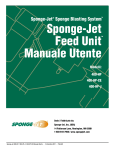


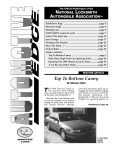
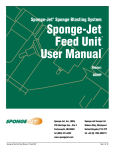
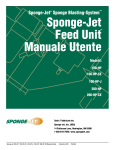


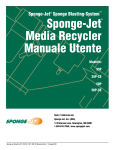
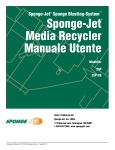
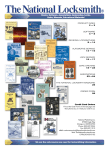
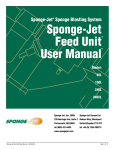
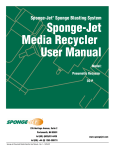
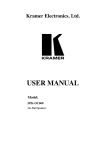
![Manual[DOWNLOAD]](http://vs1.manualzilla.com/store/data/005897454_1-7b43247b19e54aa42c3777609ebafaf8-150x150.png)
